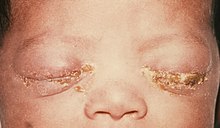| Neonatal conjunctivitis | |
|---|---|
| Other names | Ophthalmia neonatorum |
 | |
| A newborn with gonococcal ophthalmia neonatorum | |
| Specialty | Pediatrics |
Neonatal conjunctivitis is a form of conjunctivitis (inflammation of the outer eye) which affects newborn babies following birth. It is typically due to neonatal bacterial infection, although it can also be non-infectious (e.g. chemical exposure).[1] Infectious neonatal conjunctivitis is typically contracted during vaginal delivery from exposure to bacteria from the birth canal, most commonly Neisseria gonorrhoeae or Chlamydia trachomatis.[2]
Antibiotic ointment is typically applied to the newborn's eyes within 1 hour of birth as prevention for gonococcal ophthalmia.[3] This practice is recommended for all newborns and most hospitals in the United States are required by state law to apply eye drops or ointment soon after birth to prevent the disease.[4][5]
If left untreated, neonatal conjunctivitis can cause blindness.
- ^ "Conjunctivitis, Neonatal: Overview". eMedicine. 2019-05-30.
- ^ Tan, Aik-Kah (2019-01-09). "Ophthalmia Neonatorum". New England Journal of Medicine. 380 (2): e2. doi:10.1056/NEJMicm1808613. PMID 30625059. S2CID 58654865.
- ^ Matejcek, A; Goldman, RD (November 2013). "Treatment and prevention of ophthalmia neonatorum". Canadian Family Physician. 59 (11): 1187–90. PMC 3828094. PMID 24235191.
- ^ "Conjunctivitis | Pink Eye | Newborns". www.cdc.gov. Retrieved 2016-11-11.
- ^ Curry, Susan J.; Krist, Alex H.; Owens, Douglas K.; Barry, Michael J.; Caughey, Aaron B.; Davidson, Karina W.; Doubeni, Chyke A.; Epling, John W.; Kemper, Alex R.; Kubik, Martha; Landefeld, C. Seth; Mangione, Carol M.; Silverstein, Michael; Simon, Melissa A.; Tseng, Chien-Wen; Wong, John B. (29 January 2019). "Ocular Prophylaxis for Gonococcal Ophthalmia Neonatorum". JAMA. 321 (4): 394–98. doi:10.1001/jama.2018.21367. PMID 30694327.